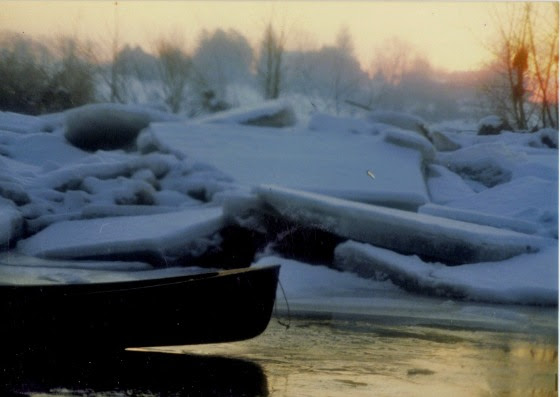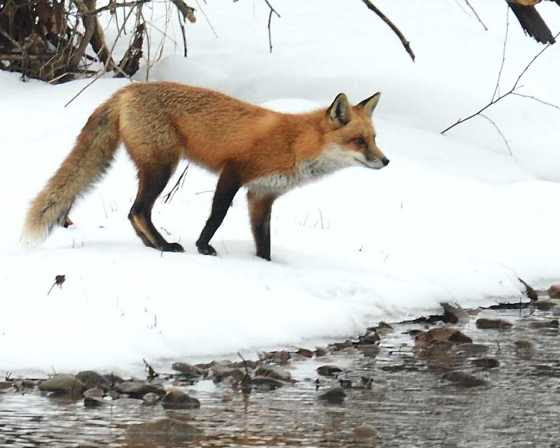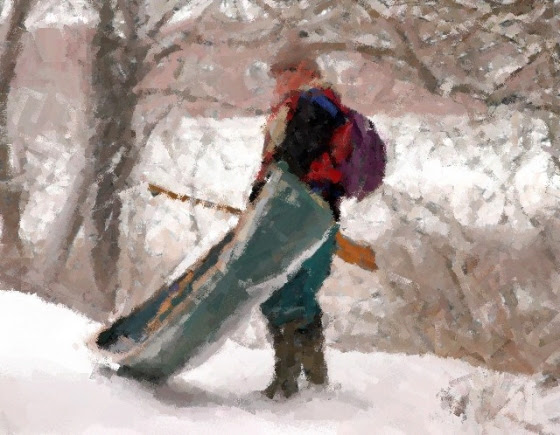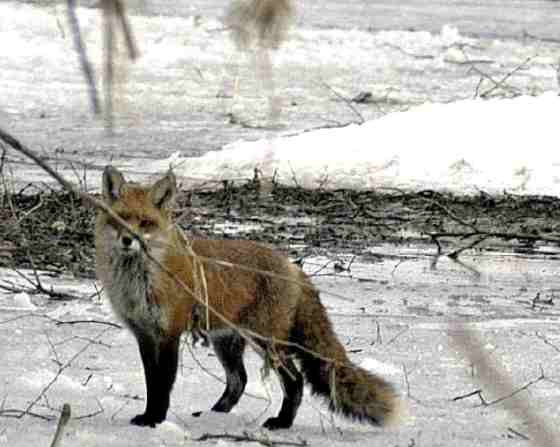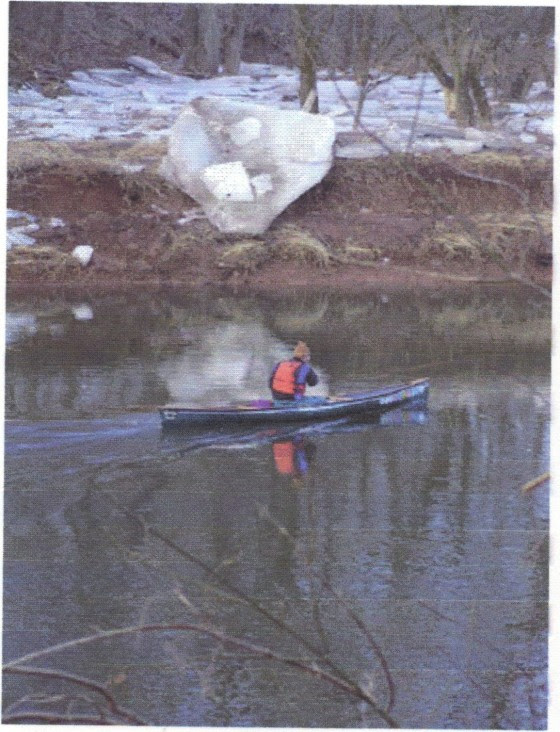Icing on the Gunnels
Essay and photos (except as noted) by author Joe Mish
Not on par with Shackleton’s adventure, the intent of this winter paddle trip was to see what nature is doing when she thinks no one is watching. Self portrait
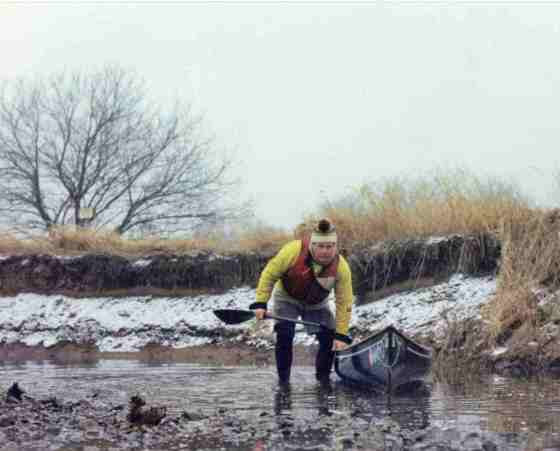
Sleepy eyes involuntarily shut to set the stage for transient dreams to vie for recollection in morning’s foggy consciousness, as a mid-winter storm promised a night of undecided precipitation.
The view through the frosted bedroom window at dawn, revealed the storm’s final decision in the form of powdery snow, preserved by an overcast sky and sub-freezing temperature.
First light of dawn appeared as a proxy of the sun who farmed out delivery of a mere fragment of daylight intended to last the day.
A long spell of cold had locked the river in ice and curtailed any thought of canoeing. A heavy rain followed to raise the water level and break up the ice. The water settled down to a suitable flow, and I was anxious to see the aftermath and capture some wildlife images in between winter’s extreme mood swings.
Predawn light reveals broken slabs of ice, thrown asunder, by swollen water from a heavy rain, followed by a dusting of powdery snow. Moody winter weather is the rule.
The air was still and not a breeze stirred, a sure sign of snow to come. The conditions were perfect, as light snow was expected about halfway through the trip, and it would add mood to any landscape or wildlife images. Wildlife tends to feel more secure and reluctant to move in sub-freezing temperatures, allowing a close approach.
View from the canoe. Digital evidence here, though so many more incredible moments in nature are retained only in the form of recoverable memories altered by time, instead of digital editing.
The camera lens is less likely to get blurred in the absence of wind-blown precipitation. If a stiff breeze was predicted, I would never launch my canoe. Wind is the rate limiting step for my winter sojourns, along with safe water levels. Safety is critical and is weighed against any cold weather canoe trip.
I placed the boat in the quiet water along the shore, just inside the edge of the current. I carefully settled into the center seat, holding the carbon fiber paddle across my lap. Out of habit, I always wait a moment after engaging with the current to feel the enthusiasm of the river’s energy to partner with my energy infused paddle strokes.
Are you sure you want to go canoeing? Photo by Mary Ellen Hill.
There can be several distinct reasons to make a downriver run on any given day, all dependent on mood, weather, and water flow. The intent of this winter paddle was to see what nature is doing when she thinks no one is watching.
Digital evidence is nice to have, but not as essential as just being present to experience what cannot otherwise be seen and felt in tamer conditions.
The female red fox hiding behind the branch along the shoreline is a trigger for the behavior that followed and not digitally captured. She looked directly at me while she moved off, and defiantly stopped in the open and still staring back at me, squatted to pee
The current is my guide, as my hull is directed to follow its winding course worn into the hard shale riverbed, especially critical at lower water levels.
Ice out! open water, adventure awaits! Image of me taken without my knowledge, by Bill Haduch. Never know what you might see on the river.
I generally use a hit and switch style of paddling where the boat is kept on course by alternate stokes instead of turning the paddle blade at the end of the stroke, which is grossly inefficient, as it slows hull speed. Though, any paddle stoke in the nick of time is the correct choice.
As I switched sides after each series of strokes, the water dripping off the paddle blade fell on the ash gunnels and instantly froze. Fine drops quickly freeze and after layers of ice accumulate, its collective weight and height above the water, moved the center of gravity forward to make the hull plow left or right with each stroke and reduce stability. An occasional pause was required to clear the gunnels of ice, using the paddle’s sharp edge to shatter the ice.
Clearing the ice was not an existential crisis and at times I would use a north woods style paddle stoke in deep water, where all paddling is done on a chosen side, never lifting the paddle from the water. This is a useful stroke when drifting up on unaware wildlife as paddling motion is restricted to the offside and the stroke, completely silent.
As I neared home pasture, a light but steady snow began to fall straight down. This was the time to allow the river’s energy to take control one last time, set aside my physical presence and exist for a meditative moment in conscious stillness. A brief side trip, compliment of the water’s endless energy.
The carry from the river through the pasture to home had its own reward. I have a pair of pile lined, heavy wool mittens stowed in a zip lock bag, reserved just for this occasion.
I rarely wear gloves when paddling in cold weather, though when I take out, stow my pack and paddles, lift the hull on my shoulders, my hands get wet and cold from the water collected in the hull. It is an anticipated treat to wear those mittens on the portage home. As I slipped on the mittens, I noticed a single flake of snow caught on an errant strand of wool, its unique structure designed as if by intelligent hand. This was the essence of a mid-winter canoe trip, ephemeral moments in nature, stored in memory for instant retrieval, to be enjoyed and shared. It was just the icing on the gunnels.
Author Joe Mish has been running wild in New Jersey since childhood when he found ways to escape his mother’s watchful eyes. He continues to trek the swamps, rivers and thickets seeking to share, with the residents and visitors, all of the state’s natural beauty hidden within full view. To read more of his writing and view more of his gorgeous photographs visit Winter Bear Rising, his wordpress blog. Joe’s series “Nature on the Raritan, Hidden in Plain View” runs monthly as part of the LRWP “Voices of the Watershed” series. Writing and photos used with permission from the author.

